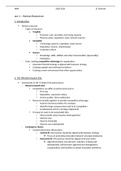HRM 2020-2021 B. Schreurs
Les 1 – Human Resources
1. Introduction
Human resources
- Types of resources
Tangible
Financial: cash, securities, borrowing capacity
Physical: plant, equipment, land, mineral reserves
Intangible
Technology: patents, copyrights, trade secrets
Reputation: brands, relationships)
Corporate culture
Human
Knowledge, skills, abilities and other characteristics (personality)
Motivation
- Goal: creating competitive advantage for organization
Important that HR strategy is aligned with business strategy
Creating capable and motivated workforce
Creating a work environment that offers opportunities
2. The HR-performance link
Investments in HR better firm performance
- Resource-based view
Competitors can differ in performance due to
Firm size
Reputation, corporate culture
Service quality, client satisfaction
Resources bundle together to provide competitive advantage
Superior business position for company
Identify things company does well to its competitors
Fundamental to firm’s strategy (alignment)
If resources want to be sustainable they
Must provide value (requires heterogeneity)
Must be rare
Must be inimitable
Must be non-substitutable
- Contingency theory
Context determines HR practices
Vertical fit: HR practices should be aligned with business strategy
Focus on promoting innovative behavior amongst employees
Horizontal fit: HR practices should be aligned with each other
Align HR practices (recruitment, selection, training and
development, performance appraisal and management,
compensation and benefits) to obtain innovative workforce
,HRM 2020-2021 B. Schreurs
- AMO framework
= Ability Motivation Opportunity
HR enhances employee’s
Skill levels
Motivation
Opportunities to participate
Leads to discretionary effort and eventually better firm performance
! RECAP !
People = source of sustainable competitive advantage
Superior firm performance HR practices vertically and horizontally aligned
HR superior firm performance by influencing peoples abilities, motivation and
opportunities to participate
,HRM 2020-2021 B. Schreurs
Les 2 – HR roles, history and future
1. Roles
Why isn’t HR taken serious?
- HR doesn’t understand all aspects of business
Widening gap between capabilities of HR employees and business acumen
(scherpzinnigheid) needed to be successful strategic partners
Most HR = industrial-organizational psychologists
- HR doesn’t contribute to the bottom line (bedrijfsresultaat)
HR uses easy-to-measure metrics instead of a metric to understand their
financial impact on the organization
- HR isn’t working for you
Treats everyone the same
Unfair? Individuals differ: unique contributions = talent management
‘Bad cop’ tool of top management
Rule enforcer to ensure fairness across the board
- Corner office doesn’t get HR and vice versa
HR only to boost morale
Corporations don’t empower HR to be strategic, even when they want to do that
Reinforces stereotype: HR not interested in increasing organizational
performance
2. HR roles according to Dave Ulrich
Roles HR-manager
₋ Axis
Horizontal
Focus on processes
Focus on people
Vertical
Focus on longterm
Focus on daily business
- 4 fields of HR
1) Administrative expert
Managing firm’s HR infrastructure (job analysis, recruitment and
selection, training and development, career management, performance
appraisal and management, compensation systems, labor legislation, HR
planning)
Process optimalization and efficiency
, HRM 2020-2021 B. Schreurs
2) Employee champion
Managing employee’s contribution (working relationships, unions,
employee involvement and participation, communication and trust,
monitoring work stress and job satisfaction, work engagement,
psychological contract)
Motivated and competent personnel
3) Change agent
Managing transformation and change (managing and supporting the
change process, preparing for change, organizational culture,
conflict/problem resolution, action plans, monitoring progress and
making change last)
Effecting transformation and change
4) Strategic partner
Aligning HR and business strategy (creating added value, translate
corporate strategy into HR-activities, aligning HR-processes, HR
information systems)
Active role in setting strategic direction
- HR roles in context
All HR professionals are operating within a certain organizational and national
context
Context can alter the importance of relevance of various HR roles
3. History of HRM
Early beginnings
- Earliest evolved management function
- Actual HRM: since functioning units bv tribes
Division of labor: some go hunting, some go farming…
= different persons occupy different roles in productive society
Pre-industrial society
- Before 1750
- Rural areas: agrarian society
Farmer’s life for bulk of population
Flexible hours
Depending on what work was needed
- Urban areas: self-employment or small businesses, artisanal and skill-based work
Association of craftsmen or merchants mutual aid AND protection of
professional interests
Guild regulations who can work at a trade, which skills need to be taught and
when to work
Industrial revolution
- 18th century Europe
- Agricultural industrial/manufacturing society
Machines replaced human labor
Rise to factory system
Change of traditional employment relationships





